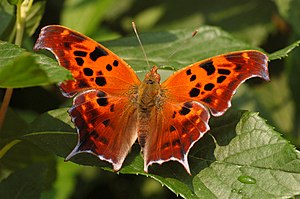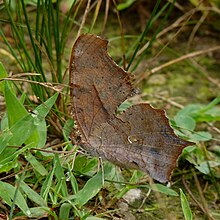Polygonia interrogationis
| Polygonia interrogationis | ||||||||||||
|---|---|---|---|---|---|---|---|---|---|---|---|---|

Polygonia interrogationis , autumn or winter form |
||||||||||||
| Systematics | ||||||||||||
|
||||||||||||
| Scientific name | ||||||||||||
| Polygonia interrogationis | ||||||||||||
| ( Fabricius , 1798) |
Polygonia interrogationis ( Syn .: Nymphalis interrogationis ) is a butterfly (day butterfly ) from the family of noble butterflies (Nymphalidae).
features
butterfly
The moths usually reach a wingspan of 45 to 68 millimeters. However, there are also specimens with a wingspan of up to 76 millimeters. The wings are strongly serrated on the outer edge and are variable in color. The basic color depends primarily on the season. The so-called "summer generation" is orange to brownish on the upper side of the front wing and almost monochrome black-brown on the rear wings. The “autumn / winter generation”, on the other hand, has an orange to brownish-red basic color. All butterflies are drawn with a black, brown and yellow spot pattern. The undersides of the wings are marbled in graduated brown tones. The white C-sign in the middle of the hind wings is noticeable, which is almost always approximately interrupted in the form of a question mark , which is why the species is also referred to as a question mark in English .
egg
The egg is pale greenish in color. It is deposited singly or in small piles of up to eight pieces on the underside of young leaves of the food plant.
Caterpillar
Adult caterpillars show a blackish basic color. The entire body is covered with many small white spots and short, strongly branched thorns. In addition, thin, orange side lines can be seen.
Doll
The doll is mostly brown in color. It has a very pronounced hump and two short tips on the head. A few silver or gold iridescent spots stand out on the back. Shortly before the moths hatch, the wing sheaths shimmer orange.
Similar species
Polygonia interrogationis resembles many species of Polygonia due to the drawing on the upper side of the wings , in particular:
- The C-butterfly ( Polygonia c-album ), which is native to Europe, North Africa and Asia and thus does not form any geographical overlap.
- Polygonia faunus is distinguished by a series of green dots on the underside of the hind wings.
- Polygonia comma can be distinguished by a strong marbling on the underside of the hind wing.
- Polygonia satyrus shows a more yellow-brown color on the upper side of the forewing.
Polygonia interrogationis also differs from the aforementioned species by the two-part C-symbol and the considerable size.
distribution and habitat
Polygonia interrogationis is found in the southeastern provinces of Canada and in the east and southeast of the United States . The distribution extends to Mexico . The animals prefer open forest areas, gardens and parklands.
Way of life
The species usually forms two generations per year. The moths of the first generation fly from June to mid-August, those of the second appear from the end of August, overwinter as moths and fly until May of the following year. At rest they like to sit on the ground and fold their wings upright. You then look like a withered leaf. This means that they can hardly be recognized by predators. The moths rarely visit flowers. Instead, they prefer watering holes, overripe fruit, and manure for ingesting food and minerals. The caterpillars mostly live individually and feed on a variety of different plants, for example the nettle family (Urticaceae), elm family (Ulmaceae) or mulberry family (Moraceae).
swell
Individual evidence
- ^ Canadian Biodiversity Information Facility
- ^ Butterflies and Moths of North America
- ↑ James A. Scott: The Butterflies of North America , Stanford University Press, Stanford CA., 1992, ISBN 0-8047-2013-4 , p. 284
- ↑ caterpillar at Bug Guide
- ↑ Featured Creatures
literature
- James A. Scott: The Butterflies of North America , Stanford University Press, Stanford CA., 1992, ISBN 0-8047-2013-4 , p. 284
Web links
- butterfliesofamerica.com - Photos
- Encyclopedia of Life - Taxonomy and Photos


